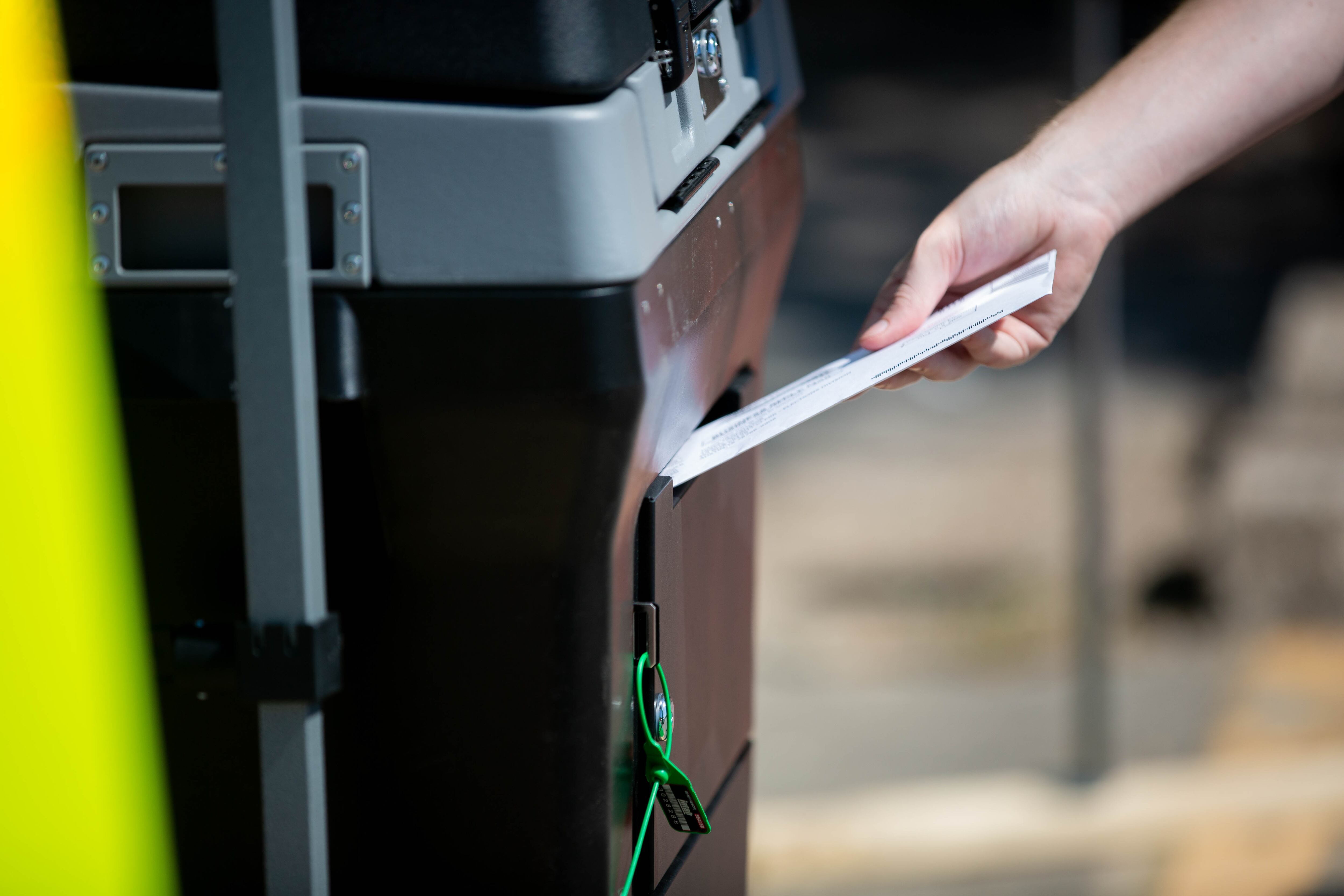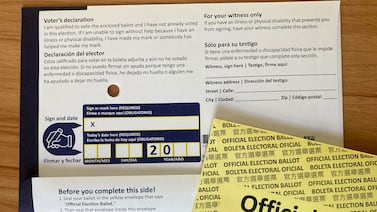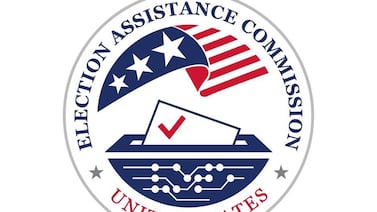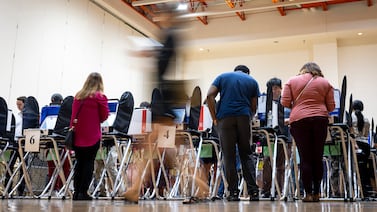Votebeat is a nonprofit news organization reporting on voting access and election administration across the U.S. Sign up for our free newsletters here.
Texas lawmakers are once again revamping requirements to vote by mail, this time with the goal of lowering rejection rates of mail-in applications and ballots.
The changes come a year after thousands of Texans’ applications were rejected due to more stringent identification requirements adopted as part of a sweeping 2021 law.
The latest round of changes, which passed with bipartisan support this legislative session, will give voters more opportunities and time to correct errors. Voters should also be able to more easily access the state’s online tracking tool for mail-in ballot applications and ballots.
Some voters are still questioning why more restrictive rules were necessary in the first place, as well as whether this year’s fixes go far enough.
“Why was everything changed? What was the problem? What are they fixing? And did they really fix it?” said Julie Espinoza, 58, of Collin County.
Espinoza has been voting by mail in Texas since the 1980s. But last year, she was unable to vote for the first time after her mail-in ballot for the March 2022 primary was never delivered. Espinoza, who uses a wheelchair and does not drive, was not able to find transportation to a polling location in time to cast a ballot.
“Now I have lost confidence. Now I am nervous that it’ll happen again and that this system might not work,” she said.
How Senate Bill 1 changed voting by mail in Texas
In summer 2021, Texas legislators, responding to false claims of widespread voter fraud, approved far-reaching election legislation that, among many other provisions, added new ID requirements to voting by mail.
Existing law already limited who could qualify to cast a mail ballot rather than an in-person ballot, primarily to older or disabled voters. Prior to Senate Bill 1, Texans who voted by mail were required to provide only their name, address, and signature.
The new law required mail voters to provide their driver’s license number or part of their Social Security number on their ballot application and carrier envelopes. When the new voting law was enacted, voters had very little time to get familiar with the new requirements, which typically arrived on forms packed with instructions written in very small print.
At the time, 1.9 million Texas voters had only one of the two numbers — either their driver’s license number or Social Security number — in the state’s voter registration database. If voters put down the wrong one, often because they didn’t remember which number they had provided when they registered, their ballot application or ballot was rejected.
Trudy Hancock, Brazos County elections administrator, told Votebeat that older voters often did not remember which ID number they used to register. They’d add one instead of the other or would simply leave that section blank.
If voters learned they had made an error on their application and wanted to correct it, they were allowed to do so only in person, “and that defeated the whole purpose of voting by mail for voters,” Hancock said. “They were angry. They’d call us and tell us that we were making it harder to vote.”
All of this led to confusion, frustration, and errors, election officials told Votebeat. And during the March 2022 primary election, only months after the governor had signed the bill into law, at least 12,000 mail ballot applications and more than 24,000 mail ballots were rejected, disproportionately impacting Asian, Latino, and Black voters.
“It really makes us question whether we live in a fair and open democracy when we have rejections at that rate. Especially with Asians being the fastest-growing demographic in Texas and becoming more civically engaged,” said Sarah Chen, a board member at Asian Texans for Justice and an attorney with the Texas Civil Rights Project. “Having a ballot rejected can be absolutely devastating for somebody who is so excited to exercise that right to participate in our democracy. ”
During the Legislature’s 2021 voting legislation debate, Republican lawmakers said Texans’ expanded mail-voting option during the COVID-19 pandemic was “convenient” but made elections more susceptible to voter fraud, although there’s no evidence of such widespread abuse. They added ID requirements previously sought by Sen. Bryan Hughes — drafted behind closed doors and without public input — requiring election workers to verify a voter’s identity and eligibility.
At a committee meeting that August, Hughes, a Mineola Republican, said Senate Bill 1 added “security measures aimed at those trying to cheat. At ballot harvesters trying to influence, trying to coerce, trying to steal votes, trying to mislead voters.”
The 2021 legislation did introduce a process for a voter to fix mistakes on their ballot application and their ballot. That year, lawmakers also passed a separate bill requiring the secretary of state to create an online tracking system for voters’ applications and ballots. However, the tool could be difficult to access because it required voters to enter their voter registration address, which had to match exactly the address the state had on file for each voter.
For example, if a voter typed in “St.” instead of “Street” or vice versa, a message would pop up that said “voter not found.” And if the state’s database had a typo in a voter’s address, which is filled in manually, that would also lead to problems accessing the system.
2023 changes to voting by mail in Texas
Throughout 2022, local election administrators across the state took note of the problems.
They mobilized to alert voters in their counties of the changes to the process. They talked to news outlets to spread the word about the new procedures and added brightly colored paper inserts to mail ballot packets, reminding voters to include their ID numbers.
By the November general election, the statewide rejection rates decreased from 12% in the March primary to 2.7%.
Then election officials told lawmakers about voters’ experiences with the new rules. Some said they are glad to see lawmakers this year listened to suggestions from election workers across the state.
“This is a very solid step in removing some of those barriers in the process,” said Remi Garza, the Cameron County elections administrator, pointing to how the changes make it easier for voters to access the online portal and correct errors without coming in person. “Every step has a deadline, and the harder it is to meet those deadlines for the voter, the harder it is for us to get their vote counted.”
This year’s Senate Bill 1599, authored by Hughes and sponsored by state Rep. John Bucy, an Austin Democrat in the House, requires election officials to notify voters of errors in their mail-in ballot application or mail-in ballot. It requires election officials to instruct voters on how to return their corrected forms by mail, in person, or through the state’s online tracking tool.
The bill will also allow election workers to begin reviewing mail-in ballots as soon as they are delivered, no later than the ninth day before Election Day.* Under previous law, small counties with a population of less than 100,000 could not begin that process until after the last day of early voting, giving them only a couple of days to do so, with fewer resources. That also meant they had less time to notify voters if they found a problem.
Another bill, House Bill 357, also authored by Hughes and sponsored by Bucy, changes the information a voter must provide in order to access the state’s online tracking tool instead of their exact voter registration address. Under this new law, voters now must provide their name, their date of birth, the last four digits of their Social Security number, and a state ID number. Both bills were signed by the governor this month.
Once the new measures take effect in September, here’s how the process will work:
A voter who qualifies to vote by mail — someone who is 65 or older, has a physical disability, is outside of the county, or is incarcerated but otherwise eligible — will need to fill out an application to vote by mail. Once it’s delivered to the county elections office, if a voter made a mistake on that application — for example, the address does not match what’s on file or maybe a voter forgot to provide their ID number — they’ll get a call or an email from an election official who’ll guide them on how to fix it and the deadlines to do so. Voters can also check the status of their application and ballot using the state’s online tracking tool. There, voters can see whether election officials flagged an error.
Texas remains one of the hardest states in which to vote, voting rights advocates say, and voting by mail is especially difficult, even for qualified voters. For instance, voters who qualify must annually request a new application to vote by mail in elections for that calendar year, and obtaining the application is hard for older voters who might have difficulty accessing the internet.
The San Antonio-based Southwest Voter Registration Project is part of a coalition of voting rights groups that sued the state over voting restrictions implemented by Senate Bill 1. The outcome of the case is pending a trial date later this year.
“Whatever changes they make,” said Lydia Camarillo, president of the Southwest Voter Registration Project, “they’re ultimately not improving the right of a voter to vote without having any issues.”
Who qualifies to vote by mail in Texas?
According to the Texas secretary of state, to be eligible to vote early by mail a voter must:
- be 65 years or older;
- be sick or disabled;
- be out of the county on election day and during the period for early voting by personal appearance;
- be expected to give birth within three weeks before or after election day; or
- be in jail but otherwise eligible.
Correction, July 10: This article originally misstated the new time frame for election workers to begin reviewing mail-in ballots before Election Day.
Natalia Contreras covers election administration and voting access for Votebeat in partnership with the Texas Tribune. Contact Natalia at ncontreras@votebeat.org.








